World War 1
The Siberian Front in WW1
Two Youtube videos of the Siberian Expedition:
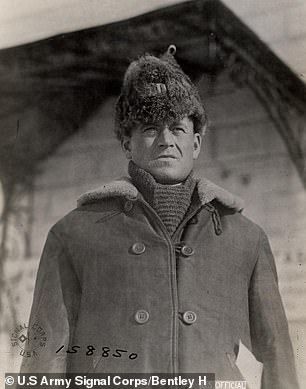
US Signal Corps Photo 158550
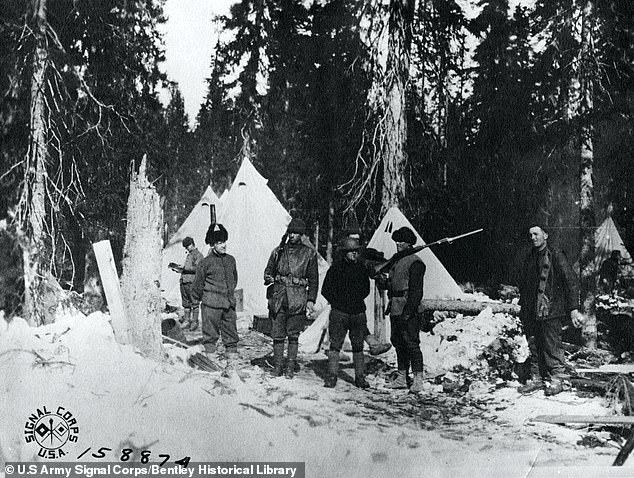
Service in Siberian snow
US Signal Corps Official Photo 158824
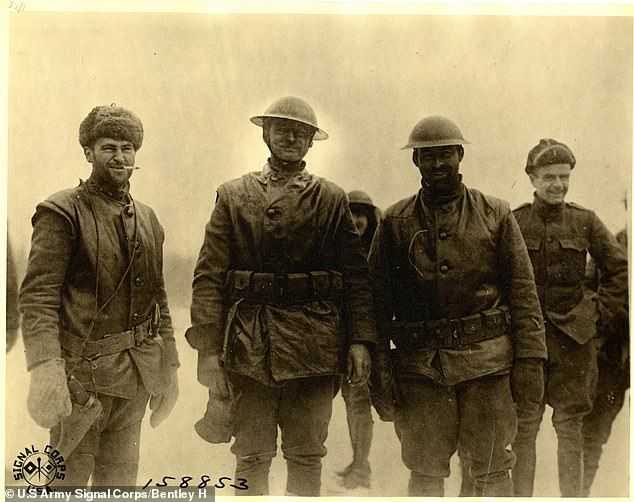
US Soldiers in Siberia
US Army Signal Corps Photo 158853

With temperatures the could 45 degrees below zero, the American forces dubbed themselves the Polar Bear Expedition.
Polar Bear Expedition Patch
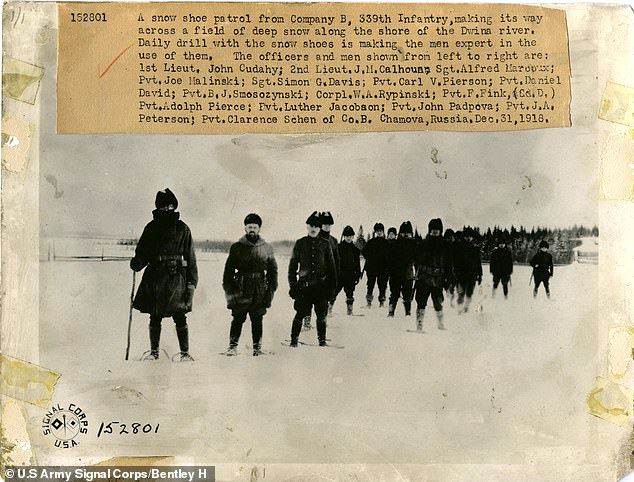
"A snowshoe patrol from Company B, 339th Infantry, making its way across a field of deep snow along the shore of the Dwina river. Daily drill with the snowshoes is making the men expert in the use of them. The officers and men shown from left to right are: 1st Lieut. John Cudahy; 2nd Lieut. J. M. Calhoun, Sgt. Alfred Mardeux; Pvt. Joe Halinski; Sgt. Sinon G. Davis; Pvt. Carl V. Pierson; Pvt. Daniel David; Pvt. B. J. Smosozynski; Corpl. W. A. Rypinski; Pvt. F. Fink, (Co. D) Pvt. Adolph Pierce; Pvt. Luther Jacobson; Pvt. John Padova; Pvt. J. A. Peterson; Pvt Clarence Schen of Co. B. Chamova, Russia, Dec. 31, 1918."
US Army Signal Corps/Bentley H Photo 152801
Leslie Alfred Neely, US Navy,
Marion County, Indiana
I was one of the 16 men sent by the USS Yankton on a landing party in northern Russia. We were further inland than any American blue jackets ever served, being about 800 miles south of Mur Mansk, the most northern Seaport.
Two submarine encounters and in the battle of Lake Omega in northern Russia.
Walter Fred Schmidt, Pfc, Co. E, 339th Infantry, 85th Div.,
Vanderburg County, Indiana
Served in Russia and in France
Battles participated in:
- Defense Seletshoe Sector November 14 - December 29, 1918
- Battle of Kodish Petrograd Road; December 30, 1918 - January 3, 1919
- Defense Emsta River; January 4 - January 14, 1919
- Defense Volgda Archangel Railroad; January 29 - March 3, 1919
- Battles of Bolske Ozenki; 18 th Verst Port, Obozenskaza, Onega Road; March 24-29, 1919
- Defense of Volgda Archangel Railroad; April 1 - April 30, 1919
- Skirmish Verst, Volgda Archangel Railroad; April 14,1999
- Defense Bolski Ozerki; May 1 to May 21, 1919
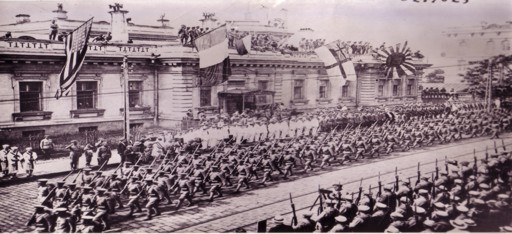
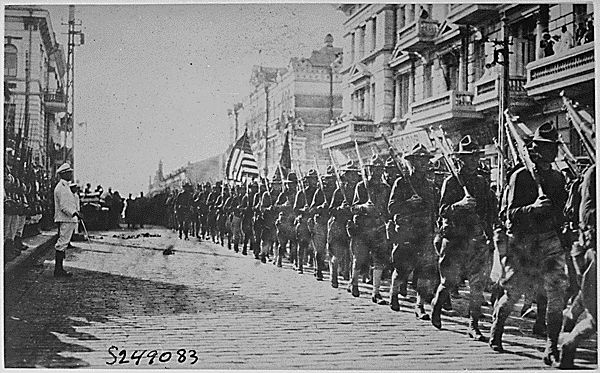
American troops in Vladivostok parading before the building occupied by the staff of the Czecho-Slovaks. Japanese marines are standing at attention as they march by. Siberia, August 1918. Underwood and Underwood.;
Intervention in Russia
7,950 American troops were sent to the far eastern side of Russia in August of 1919. The US had nearly a billion dollars invested in guns and equipment on the Trans-Siberian highway between Vladivostok and Nicolsk that President Woodrow Willson wanted to protect. The equipment has been sent there to aid Russian against the Central Powers, Wilson hoped Russia would emerge a democratic country and his actions lead America to become involved in the Russian Civil War. The Allies hoped to create an American-run Russian railway service and had sent three hundred locomotives and over ten thousand railway cars. Bad weather and politics delayed the Russian service from actually being established.
Major General William S Graves of the 8th Division was placed in charge of the Siberian Expedition. The American forces included men from the 12th, 13th and 62nd Infantry of the 8th Division. The Allied forces in Siberia consisted of America, British, French, Japanese, and Czech troops. The Siberian Expeditionary Forces served under combat conditions, in a brutal environment, longer than any other force involved in WW 1.
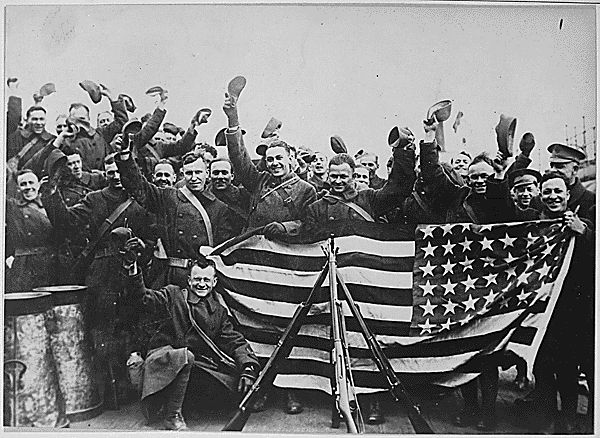
"American troops in Russian port about to leave that country. They are here cheering and displaying the stars and stripes as the tender was coming for them."
Central News Photo Service
Soldiers Stories:
Pvt. Samuel Herbert Darrah, Co. K, 339th Infantry, 85th Div.,
Marion County, Indiana
Croix de Guerre w/ bronze star (France):
Lead an advance patrol to establish a machine gun location.
They were mistaken for the enemy & fired upon by the enemy and Canadian & US forces.
Battles: Saletskoe, Yemsta River, Kadish ( Russia)
“I will now tell you a little of my experiences and why the American boys were in Northern Russia 3,000 miles north of Siberia, Russia at the North Pole. We were loaned to England by America to fight the Reds, and I spent the fall and winter of 1918 in Northern Russia where it runs from 45 to 47° below zero, which I saw with my own eyes on New Year's Day. I spent two days and nights in battle with the Bolsheviks, lying on the top of four foot of snow, and it was 47 below zero. We lost about a hundred men in about two hours on New Year's night.
Two months before this operation, party comrades had built a front against four battalions of the Red Army before we were forced to retreat. We retreated on the ninth of November, 1918 the day I was 27 years of age, the day I will long time remember. I spent five long months at the front, my lungs hurt me so bad that I couldn't hardly breathe without howling and begged to have permit to go to doctor for medicine but was refused by my Sergeant, on account of we were so very short of men and needed everyone that was able to walk.
Our company was all shot to pieces, as we were known all through the Red Army as the Black Co. of Death to the Red Army soldiers, as they always knew when they were up against Co. K. of the 339th Regiment for we occupied Kadish on one drive with 95 men against 600 Red Army soldiers and they lost over 300 men. A boy that has seen service in Russia sure has seen service in hell, for they were starving there and I have cried lots of times while I was there over being hungry.
The first square meal that I ate since I left the States was when I was in Brest, France, the 21st day of June, 1919 when I was on my way back to America, and I sure thought I was in a palace of some kind, to what it was in Russia. With the mud colored crows that are black and white and brown and we were treated more like dogs and beasts in Russia, under the English command, than we were treated like humans.
And I spent eleven months without a payday for money was no good to us, for there wasn’t anything there to buy. I spent thirteen weeks there, on the front, without an overcoat, all that I had was my blouse and the front of my trousers, and had not had a shower or bath in all of that time, as we didn’t get a chance to bath, only in the ice.”